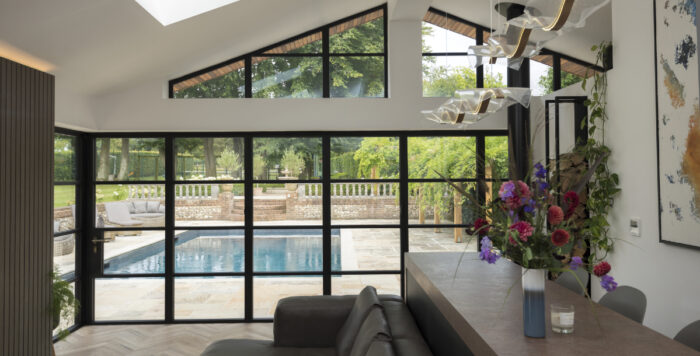How to prevent sound pollution in an open-plan kitchen
Advice on keeping the noise down in a multipurpose space
Open-plan kitchen and living spaces are great when you want to create a sense of easy social interaction. Knocking through into smaller rooms will also make the floor plan feel bigger. But it does mean that noise from appliances and clattering pans can travel through to dining and relaxation areas. Wondering how to prevent sound pollution in an open-plan kitchen? Sean O’Donnell, design consultant at Burlanes Interiors, offers some helpful advice.
Plan the layout
‘Design the food preparation and cooking area of your kitchen so that it is as far as possible from where you are going to be sitting and eating,’ says Sean. ‘Dedicating the opposite ends of your open-plan space for cooking and relaxing lessens the level of noise in your quiet zone.
‘Folding screens or pocket doors will also help keep noise at bay. It’s is a great way to create a relaxation area or quiet corner for a home office,’ he adds.

Harry and Briony’s Grand Designs home in North Cornwall. Photo: Mark Bolton
Carve out a cosy spot
Use a new or existing half wall to create a secluded seating area that blocks noise from food preparation areas. A built-in bench or banquette with a high back will also help create a sense of privacy and quiet calm in an open-plan room.

Illume Click vinyl tiles in Sandstone Concrete from Quick-Step
Choose quiet appliances
‘Check the decibel ratings of any new appliances, before you buy. Particularly the extractor fan as this is likely to generate the most noise,’ says Sean. ‘Look for products that have Quiet Mark certification, as they will have passed stringent tests for sound.
‘Another option to prevent sound pollution in an open-plan kitchen is to muffle any sound that is produced by housing integrated appliances in cabinets with well-fitting doors. Opt for soft-close hinges so that slamming doors don’t create another source of noise pollution.’

This new-build gabled house by Side Angle Side features Fisher & Paykel‘s Quiet Mark-accredited Double Dishdrawer Sanitise DD60DDFHX9 dishwasher. Photo: Casey Dunn
Install soundproof materials
‘Adding soundproof plasterboard such as those from JCW Acoustic Supplies to the walls and ceiling is an unobtrusive and effective noise-dampening solution,’ says Sean. ‘Flooring such as cork or luxury vinyl tiles (LVTs) also absorbs sound. These are particularly useful in a big space with high ceilings that might otherwise act like an echo chamber.’

A modern open-plan kitchen-diner extension in Winchester. Photo: Julian Cornish-Trestrail
Add texture
‘Soft furnishings are great sound absorbers,’ says Sean, who advises adding rugs, cushions and curtains to dining and relaxation areas to stop noise bouncing around.
But if you’re trying to keep your look minimalist, try wood panelling on the walls instead. WoodUpp’s Akupanel is an acoustic wooden-slat wall panel that’s designed to look great and absorb sound waves that would otherwise reverberate throughout the space. It works particularly well in rooms with hard, bare surfaces. It’s also Quiet Mark certified.

WoodUpp’s Akupanel acoustic wooden-slat wall panel









